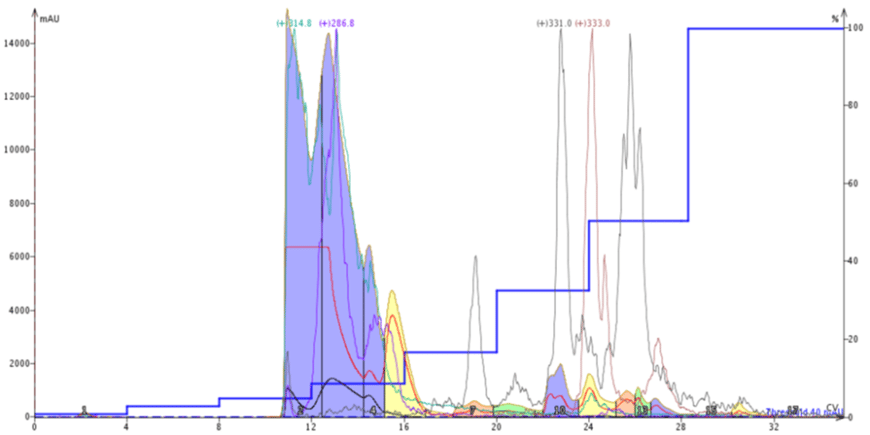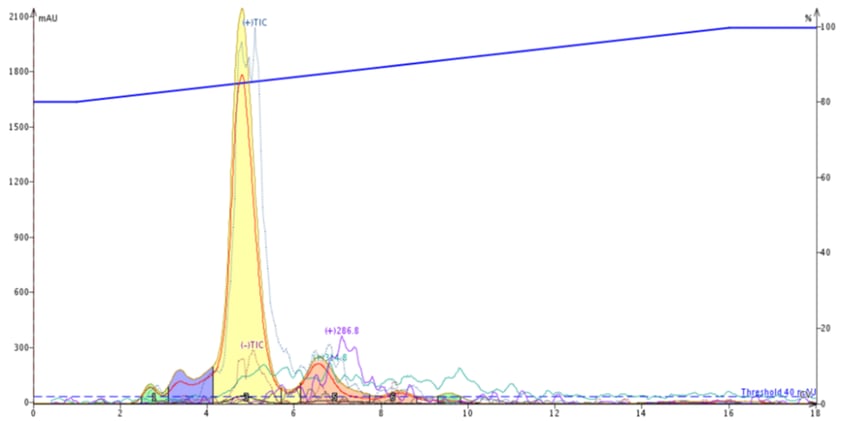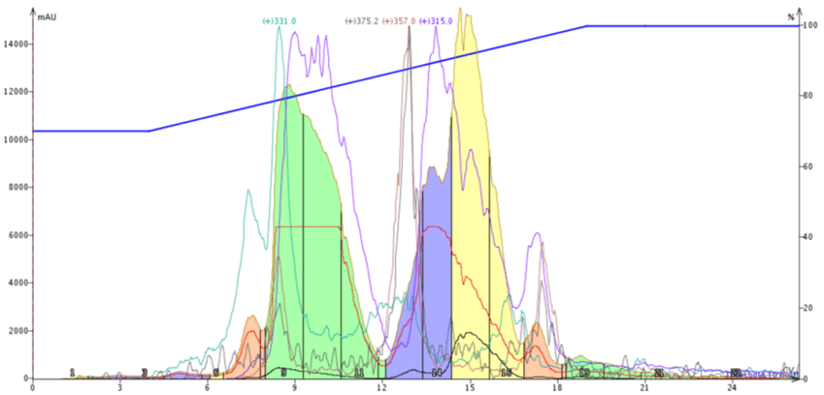Cannabinoids, naturally occurring compounds found mainly in cannabis and hemp, have seen significant research as potential new therapeutics during the past four to five years with the passing of the 2018 Hemp Farming Act bill. Initially, cannabidiol (CBD) was the primary cannabinoid of interest and many entrepreneurs created businesses to help support growing demand. To produce CBD, extraction, distillation, and purification equipment, including flash chromatography systems, are all needed during the workflow.
However, increases in CBD supply meant that retail prices dropped and the cost to produce and purify eventually became greater than what the market would accept, leaving many of these startup companies to either go out of business or diversify their product offering.
Many of those choosing to diversify turned to isolating other cannabinoids of potential therapeutic or medicinal interest present in lower levels in the natural plants; cannabigerol (CBG), cannabichromene (CBC), CBN (cannabinol), and cannabicitran (CBCT), to name a few.
One purification technique commonly used is distillation since most cannabinoids have different boiling points. However, this approach may not always provide the highest purity product due to the extracts’ chemical complexity. This issue was reported by McFarland and Russo regarding the challenges of separating CBD (boiling point 180 °C) from THC (boiling point 157 °C) (McFarland & Russo, 2001) via distillation. That’s where flash chromatography provides a solution as it easily separates CBD from the more lipophilic THC.
However, that begs the question of how well do distillation and flash chromatography methods work to separate and isolate the “minor” cannabinoids? While distillation may be effective at separating some of these, based on the issues reported by McFarland and Russo, we believe flash chromatography likely is the better option.
Historically, reversed-phase flash chromatography has been the go-to purification technique, especially for CBD as mentioned above. It can remove most, if not all, of the THC from the distillate. Reversed-phase flash also can separate CBD from most other cannabinoids with the major exception of CBG and some other, very minor polar cannabinoids with higher molecular weights (+m/z 331, 333), which co-elute with it. Other, more lipophilic cannabinoids (CBC, CBCT), however, can be separated from CBD quite easily using flash chromatography.
So, how can you separate CBG and the other, co-eluting polar cannabinoids from CBD and other cannabinoids? Well, you can try distillation as CBG has a significantly higher boiling point (470 °C)[1] but this can take a while and there is no guarantee the other, unknown polar cannabinoids will distill at different temperatures than CBD or CBG. Or, you can use normal-phase flash chromatography and get it at least partially purified within a matter of minutes, Figure 1.

Figure 1. Normal-phase flash chromatography of hemp distillate. CBG is the larger yellow peak. The other polar cannabinoids (+m/z 331, 333) are retained well, eluting late in the purification.
For this work I used a Biotage® Isolera Dalton 2000 to identify the masses of the eluting compounds, a 10-gram Biotage® Sfär HC column, and a hexanes-methyl t-butyl ether (MTBE) step gradient. After the normal-phase purification, the partially purified CBG was re-purified by reversed-phase flash chromatography (Biotage® Sfär C18, 12-gram) using a water-methanol gradient to increase its overall purity, Figure 2.

Figure 2. Reversed-phase flash purification of the normal-phase CBG fraction (yellow peak) showed a high purity level .
As seen in Figure 1, normal-phase flash chromatography is also more adept at removing the polar cannabinoids (+m/z 331, 333) than reversed-phase flash purification where they co-elute with CBD, Figure 3.
Figure 3. Reversed-phase flash purification of hemp distillate using a Biotage® Isolera Dalton 2000. Co-eluting polar cannabinoids (with CBD, large green peak) include those with +m/z 331 and 333.
The other polar, co-eluting cannabinoids with +m/z 331 and 333, which were separated by normal-phase, were then re-purified by reversed-phase flash yielding each compound with increased purity, Figure 4.
Figure 4. Reversed-phase purification of the polar cannabinoids from Figure 1. Left - fraction 10 (+m/z 331). Right - fraction 11 (+m/z 333).
While I do not know the identities of these two cannabinoids, they, like most cannabinoids, are of interest to those researching the potential therapeutic benefits these natural products may provide.
Other minor cannabinoid purifications about which I have previously posted include, CBN, CBC, and CBCT, all found on our website.
Interested in learning more about hemp cannabinoid purification? Please visit our website – Biotage.com
[1] ChemSpider.com

 Organic Workflow
Organic Workflow Peptide Workflow
Peptide Workflow Scale-Up Flash Purification
Scale-Up Flash Purification  Sample Preparation
Sample Preparation Biomolecule Purification
Biomolecule Purification Oligo synthesis
Oligo synthesis Scavengers and Reagents
Scavengers and Reagents Service & Support
Service & Support Accessories & Spare parts
Accessories & Spare parts Investors
Investors Reports & News
Reports & News The Share
The Share Corporate Governance
Corporate Governance Calendar
Calendar Sustainability
Sustainability Our Offering
Our Offering Our History
Our History Our Locations
Our Locations Leadership
Leadership